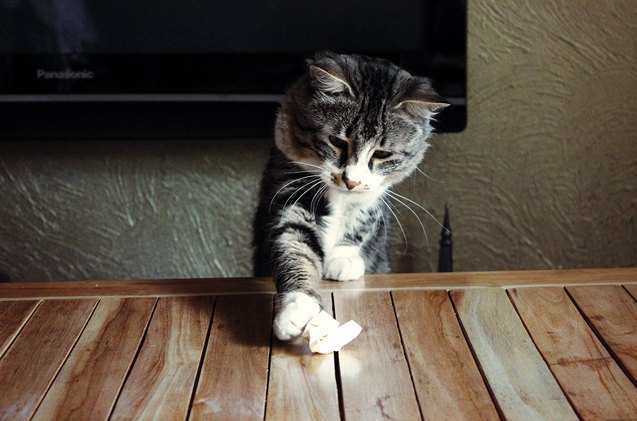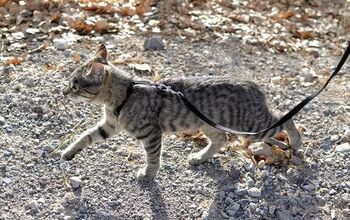5 Helpful Cat Training Tips To Control Your Frisky Feline

Dogs aren’t the only pets that benefit from training. Cat training is possible – here’s how to teach your kitty a few new tricks!
Even though many people think it’s too difficult or even impossible to train cats, this simply is not true. You just have to understand how to motivate your cat to listen to your commands, keeping in mind that many of the same tactics that are used on dogs simply won’t work on felines because they are more independent and, unlike dogs, they are not always ready to do whatever it takes to please you.
With the right strategies and tactics in place, you can train your cat successfully while strengthening your bond with your beloved pet. Below are a few tips to help you get started.
Related: Common Bad Behavior Issues And How To Fix Them
1. Stick with Positive Reinforcement
Whenever you attempt cat training, it’s best to stick with positive reinforcement by rewarding good behaviors. Punishing a cat for bad behavior will not work and will only result in your cat being fearful and anxious around you, and your pet will simply avoid getting caught making the same mistakes in the future. Punishment also results in high levels of stress, which can contribute to health and behavioral problems, such as eliminating outside of the litter box or grooming excessively.
Also, if you punish a cat for bad behavior after some time has passed, he will not associate the punishment with the behavior anyway. That’s why it is always best to stick with positive reinforcement that lets your cat know what behaviors are acceptable and will result in rewards that he will enjoy. This will make him more inclined to do the things that make you happy and, in turn, produce rewards like treats that he loves. Basically, if your cat is doing something right, you can get his attention and let him know that you’re pleased by giving him a reward of some kind. This could help him begin to associate that behavior with praise.
When it comes to using positive reinforcement, you can certainly use your kitty’s favorite food, such as a yummy treat that he can’t resist, as a reward. But talking to your pet and praising him while petting him may also help reinforce good behaviors. Just keep in mind that this needs to happen on a regular basis so you can teach your cat over time which behaviors are desirable and which ones aren’t (example: using the scratching post rather than your furniture).
Related: How To Toilet Train Your Cat
2. Use Treats and a Clicker
Whether you have been a cat parent for a long time or you are new to the world of having a feline as part of your family, one thing that becomes obvious in no time at all is that kitties love to eat. This is why the use of food and treats can come in really handy. But, in addition to treats, there’s another tool you can use to teach your cat: the clicker.
How can you incorporate the use of a clicker? Well, it’s not all that complicated. First, choose treats that your cat can’t resist and use them to get him to behave in the way that you want him to. Whenever he exhibits that behavior, such as sitting when he’s told, you can use the clicker and give him the treat.
For example, if you want to reward your cat for being patient while you prepare his food, you can give him a treat and use the clicker as well. Let’s say you want to get him to sit quietly. In that case, you might try holding the treat to his nose and then moving it in an arc over the top of his head so that he will naturally follow it and end up in a seated position, at which point you can give him the treat. Do this several times and your cat will get the idea. But, to make your training more efficient and effective, you can use a clicker at the moment your cat exhibits the desired behavior, and follow the click with a treat. So, if you’re finding that using treats alone isn’t working as well as you’d like, getting a clicker might do the trick.
Tip: Repetition is the key to successful cat training, so be patient and don’t expect changes overnight.
3. Avoid Bad Behaviors Through Play
Sometimes, kitties misbehave because they are bored or they aren’t getting enough playtime with you. So, in addition to using other strategies, consider using play and exercise in an effort to avoid negative behaviors.
How does this work? Well, training your cat to release excess energy through play is yet another way to prevent him from acting out in destructive ways. Instead of, say, jumping on your furniture and knocking things to the ground, he will use that energy to chase down his favorite toys. And the best part about this strategy is that it’s fun and amusing for both you and your cat. Plus, it is a wonderful way to bond with your feline companion.
So, to summarize: just set aside time each day to play with your cat using a variety of toys, from wands with feathers to catnip balls. Keep in mind that the goal is to get your kitty to move, release energy, get some exercise, and feel happy while experiencing the thrill of the hunt. This activity time will also tire him out so that he will no longer have energy to expend and he won’t be bored. And, as mentioned above, this can help strengthen your bond and prevent negative attention-seeking behaviors.
4. Keep the Training Sessions Short
Another thing to keep in mind is that felines have short attention spans, so you want to keep your training sessions short. About 15 minutes or so should be long enough, but your cat may become bored even sooner than that.
Every kitty is different, so it might take some time to learn his tolerance for training and to figure out how long you can hold his attention. Always work with your pet, without forcing him to do something, and stop the training once you notice that he is no longer interested or paying attention.
Again, consistency is key, so train every day if you can, preferably before mealtime so he is motivated by the reward of food. And if you can make it enjoyable for both of you, it’s a win-win.
5. Wean Your Cat off Treats
Although treats are great motivators at the beginning of a cat training program, too many treats might not be healthy for your kitty and might lead to weight gain. So, after some time, you may want to come up with other rewards that will satisfy your cat just as much as food.
It might take time, but the goal is to wean your cat off the treats by incorporating other rewards. This could include a specific toy that he loves playing with, some catnip that excites him, or positive statements combined with petting that show him how good he did while you praise him for a job well done. Remember to make these changes slowly and steadily, rather than abruptly. Basically, reduce the number of treats you give to your cat after a good behavior until they are no longer necessary, but continue with rewards and plenty of love.

Lisa Selvaggio is a freelance writer and editor, and our resident cats-pert, with certifications in pet nutrition and pet first aid. She enjoys producing content that helps people understand animals better so they can give their pets a safe and happy home.
More by Lisa Selvaggio























